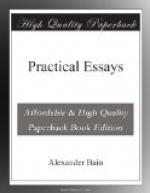* * * * *
The practical problem of Study is not to be approached by any high priori road; in other words, by setting out from abstract principles as to the nature of the mind’s receptivity and the operation of book-reading upon that receptivity. A humbler line of approach will be more likely to succeed.
There exist a number of received maxims on study, the result of many men’s experience and wisdom. Our endeavour will be to collect these, arrange them in a methodical plan, so that they may give mutual aid, and supply each other’s defects. We shall go a little farther, and criticise them according to the best available lights; and, when too vague or sweeping, supply needful qualifications.
The Choice of Books, in the first instance, depends on the merits attributed to them severally by persons most conversant with the special department. In some degree, too, this choice is controlled by the consideration of the best modes of study, as will soon be apparent.
* * * * *
[A TEXT-BOOK-IN-CHIEF.]
1. Our first maxim is—“Select a Text-book-in-chief”. The meaning is, that when a large subject is to be overtaken by book study alone, some one work should be chosen to apply to, in the first instance, which work should be conned and mastered before any other is taken up. There being, in most subjects, a variety of good books, the thorough student will not be satisfied in the long run without consulting several, and perhaps making a study of them all; yet, it is unwise to distract the attention with more than one, while the elements are to be learnt. In Geometry, the pupil begins upon Euclid, or some other compendium, and is not allowed to deviate from the single line of his author. If he is once thoroughly at home on the main ideas and the leading propositions of Geometry, he is safe in dipping into other manuals, in comparing the differences of treatment, and in widening his knowledge by additional theorems, and by various modes of demonstration.
In principle, the maxim is generally allowed. Nevertheless, it is often departed from in practice. This happens in several ways.
[MILTON’S PLAN WITH HIS PUPILS.]
[KEEPING TO A SINGLE LINE OF THOUGHT.]
One way is exemplified in Milton’s Tractate, already referred to. His method of teaching any subject would appear to have been to take, the received authors, and to read them one after another, probably according to date; the reading pace, and degree of concentration, being apparently equal all through. His six authors on Rhetoric were—Plato (select Dialogues, of course), Aristotle, Phalereus, Cicero, Hermogenes, Longinus. To read their several treatises through in the order named, with equal attention, would undoubtedly leave in the mind a good many thoughts on Rhetoric, but in a somewhat chaotic state. Much better would it have been to have adopted a Text-book-in-chief,




